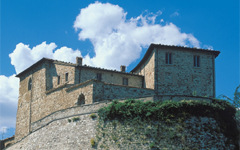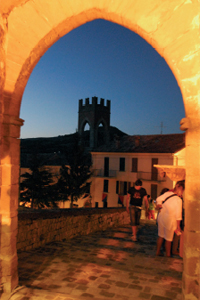Monte Cerignone

Montecerignone is a small village built on a crag, towered by a peculiar rocky Fortress of the 13th century. The Castrum, placed on a old strategic position, became the Montefeltro’s Papal Court seat. During the 15th century it was changed by Duke Federico of the Montefeltro in a summer hunting residence and modified by Francesco di Giorgio Martini into its current architectural shell. The original historical centre of Montecerignone preserves its 15th century framework. From the nice Renaissance Begni’s Square to the foot of the Fortress an alley leads to interesting churches.
The parish church takes care of a precious 12th century Latin cross, traditionally ascribed to Crusaders; the small 17th century Madonna del Divino Soccorso Church is placed side by side with the monumental 15th century Santa Caterina Church. Today, the hall of Santa Caterina Church is a multi-purpose room, but in the past it was the Knights of Malta’s chantry, of which still preserves the Cross emblem. The central Caterina’s Square gave birth to Giovanni Manganelli, later become Pope Clemente the Fourteenth. Descending towards the river you can find the small hamlet, that is a part of the village built nearby the Conca river. Here you can admire 15th century architectural units and a working mill.
:: Interesting Sites
Museo Fotografico Mochi (foto d’epoca 1897-1943 chiesa di Santa Caterina)
Museo del Caffè (Rocca Feltresca)
Suggestivo borgo medievale
Santuario del Beato Domenico (XVI sec.)
Chiesa di Santa Caterina (XVII sec.)
Rocca Feltresca (XIII sec.)
Chiesa Santa Maria del Soccorso (XVII sec.)
:: Events
Mons Cerignonis, rievocazione storica medievale - primi di luglio
Sagra del Bustrengo - agosto
:: Info
Comune tel: 0541.978522
e-mail: comune.moncerignone@provincia.ps.it
web: www.comune.montecerignone.pu.it
Ufficio Turistico, Pro loco: 0541.978713
The village and its springs
Blessed Domenico is the real thaumaturgist Saint of Montefeltro: tradition has it that people asked for faith cures by lying down the urn where the Blessed Domenico’s body is remained intact over the centuries and drinking the miraculous spring water near a monastery, “Conventino”, founded by the Saint himself. It is said that there is another miraculous spring, in the hamlet of Val di Teva, able to give fertility and genertive power to people who drink its waters. Montecerignone, as you can see, is a generous and fertile place. The same place in which Umberto Eco built his buen retiro, and which inspired him to write the setting of his masterpiece: “The Name of the Rose”.





